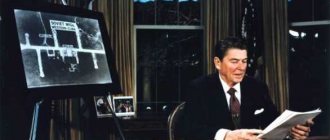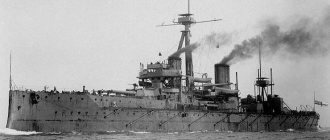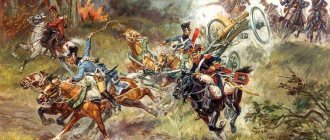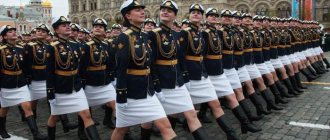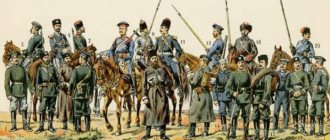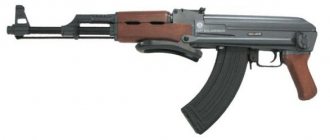Knives in Rus'. Story
Date: 12/30/2021
Unlike swords, spears and axes, knives in Russia were extremely common. This, in particular, is evidenced by archaeological material, in which this category of finds amounts to dozens...
More details
The heritage of past times, which has acquired material and cultural significance for our contemporaries, is usually called the term “antiques”. These can be masterpieces of painting or other works of art, handicrafts of artisans, factory-made or factory-made products. Items common in everyday life, items of clothing, weapons of various types, personal accessories and much more - all this is a subject of interest to those who consider it a great success to buy antiques as an investment or as an addition to a personal collection.
Sale of military antiques
The sale of antiques dating back to the period of World War II traditionally attracts a wide range of buyers. You can buy such goods from private collectors, as well as from those involved in military archaeology. If you are interested in the opportunity to buy military antiques in Moscow, then here, in addition to individual sellers, there are specialized stores that are happy to offer you items related to the front and rear of the Great Patriotic War.
Military antiques: online store Antik1941.ru
Our antique store is located in Moscow.
Antik1941.ru was founded in 2004 and today is a large specialized platform for the sale of antique items from the Second World War, World War I, and the Vietnam War. Many years of experience in the specialized market and extensive connections have allowed our store to form one of the most extensive collections of military antiques, the diversity of which we are in a hurry to present to Antik1941.ru clients. For anyone interested in antiques, the online store Antik1941.ru offers the following types of goods:
· weapons of the Second World War, as well as other military campaigns mentioned above; · military uniform of the Red Army, the Wehrmacht and other warring parties; · items of soldier's and officer's life: equipment, ammunition, dishes, personal belongings and much more; · awards: a large selection of Orders and Medals.
Antik1941.ru including a numismatic online store: we offer ancient and rare coins, banknotes, bonds.
About our products and the work of the store
All items and weapons that our online store offers are genuine, which is guaranteed by many years of experience and our authority among customers. The products contained in the Antik1941.ru catalog correspond to their descriptions, the results of which are available to customers. At the same time, the prices in our store are some of the best on the market. Delivery of purchased military antiques is carried out by courier in Moscow, as well as to the regions of Russia using postal services. You can find out more about any of the products presented, as well as find out more about delivery options by calling the numbers listed on the website.
Our online resource is an excellent find for professional antique dealers, collectors and history buffs. Often those who want to make an original gift come to us. The trade in military antiques has become increasingly popular in recent years, and the desire for great moments and mysteries of history is increasingly disturbing the hearts of our compatriots. Many agree that nothing can bring a person closer to an era better than things from seemingly forgotten times. With the help of antiques, the war and its way of life become accessible not only from the point of view of harsh front-line chronicles, but also through clear examples, which are the exhibits that our antiques store presents.
On non-involvement in Nazi propaganda
It was Antik1941.ru that assembled an amazing collection of military antiques, which is regularly updated with new arrivals. The most extensive collections are paraphernalia and objects of the workers' and peasants' Red Army and the Third Reich. Numerous things that belonged to the German army and its soldiers quite often have fascist symbols applied to them. We hasten to assure that the sale of such items should in no way be associated by our customers with the propaganda of a prohibited ideology. It’s all about the historical authenticity of the collection and the desire to present history from its true position.
18th century military uniform
In the Russian Empire, after the death of Peter the Great in the subsequent years of the reign of the Russian monarchs, the form of uniforms changed, but in general the patterns of Peter I were preserved, only they became more and more complicated, especially after the Seven Years' War, which entailed the cult of the Prussian king Frederick II the Great. The desire for convenience in the form of uniforms was completely forgotten; it was replaced by the desire to make a good-looking soldier out of him and give him such uniforms that it would take all his free time from service to keep them in order.
Military uniform of the Russian army of the 18th - early 19th centuries.
1. Officer of an infantry regiment (during the reign of Anna Ioannovna, 1732-1742). 2. Officer of the hussar regiment (during the reign of Catherine II, 1776-1782). 3. Grenadier of the musketeer regiment (the period of the monarchy of Paul I, 1797-1801). 4. Officer of the Jaeger Regiment (during the reign of Emperor Paul I, 1796-1801).
The soldier spent a particularly large amount of time keeping his hair in order; they combed their hair into two curls and a braid and powdered it while on foot; In the equestrian, it was allowed not to powder the hair and not to curl it in curls, taking it into one tight braid, but it was required to grow and comb the mustache high or, for those who did not have one, to have false ones. The soldier's clothing was extremely tight, which was caused by the requirement of the then standing position and especially marching without bending the knees. Many units of the troops had elk trousers, which were wetted and dried in public before putting them on. This uniform was so inconvenient that in the training manual the recruit was ordered to put it on no earlier than three months later, having first taught the soldier to stand upright and walk, and even with this condition “put it on little by little, from week to week, so as not to suddenly tie him up and disturb him.”
The uniform uniform during the reign of Peter III and the subsequent reign of Catherine II was observed, especially in the guard, very inaccurately, and even in the army, unit commanders allowed themselves to change the uniform without permission. Guards officers almost never wore uniforms when out of formation. All this gave rise to ideas about a change in military uniform, which was changed at the end of Catherine’s reign at the insistence of Prince Potemkin, who said that “curling, powdering, braiding hair - is this a soldier’s job? Everyone must agree that it is healthier to wash and comb your hair than to burden it with powder, lard, flour, hairpins, and braids. A soldier’s toilet should be such that when it’s up, it’s ready.”
The army's uniform was greatly simplified and made much more convenient; it consisted of a wide caftan and trousers tucked into high boots; but in the cavalry and especially in the guard, military uniform remained as before in the form of a shiny and uncomfortable uniform, although complex hairstyles and leggings disappeared from the ordinary uniform of troops. Paul I transplanted entirely Prussian military uniforms to Russia. The uniform consisted of a wide and long uniform with tails and a turn-down collar, narrow and short trousers, patent leather shoes, stockings with garters and boots and a small triangular hat.
Regiment from regiment differed in the color of their collars and cuffs, but these colors were without any system and extremely variegated, difficult to remember and difficult to distinguish, since the number of colors included such as apricot, isabella, celadon, sand, etc. Hairstyles are once again becoming important; soldiers powder their hair and braid it into braids of the prescribed length with a bow at the end; The hairstyle was so complex that the troops had special hairdressers.
Military uniform of the Russian army under Peter III and the end of the 18th century during the time of Paul I.
1. Carabinieri during the reign of Peter III. 2. Non-commissioned officer, hussar of the Life Guards of Paul I. 3. Private cuirassier during the reign of Emperor Paul I. 4. Flute player of the Preobrazhensky Regiment during the reign of Emperor Paul I.
Compliance with the uniform was mandatory, sometimes under penalty of exile to Siberia. All this caused sharp criticism from Suvorov, who said: “There are no more lousy Prussians; You won’t be able to walk through the Schillothouse or near the booth without getting infected, and the stench of their headdress will make you faint. We were clean from the muck (parasites), but now they have become the soldiers’ first nuisance. Stilettos pus on the feet.” He also composed a quatrain for the soldiers’ uniforms: “A scythe is not a sword, powder is not gunpowder, and we are not Prussians, but Russians.” For the sake of the spectacular theatrical appearance of the formation, non-commissioned officers and officers had halberds instead of firearms, and their swords dangled between the coattails of their uniforms; then all the leaders had sticks with bone knobs in their hands. These were the same “corporal’s sticks” that one should fear more than an enemy bullet. Grenadiers received tall cone-shaped hats with a large metal shield in front; These hats, like a ceremonial headdress, have been preserved to this day in the Pavlovsky Life Guards Regiment. All the uniform and all the equipment of the Pavlovian soldier were adapted for the parade ground; even the guns were not designed for shooting, but for techniques. According to eyewitnesses, the soldiers suffered most during the campaign from patent leather shoes and tight pants, which chafed their legs.
The uniform of sailors during the period from Peter I to Catherine II hardly changed, but only became more complicated; The sides and collars of the camisoles of the highest ranks are embroidered with gold, boots are put on their feet, the hair is collected in curls and braids and powdered. There was quite a significant variety of uniforms in the period from 1764 to the beginning of the 19th century; During this time, naval artillerymen had all their uniforms red, their headgear was helmets with a bear crest; The sailors' combat camisoles were white with the same lapels, double-breasted, with a gray-green collar and cuffs, and the working camisoles, the so-called bostrogs, were single-breasted grey-green, in both cases short trousers to the knees, white linen in summer; high boots; The hat was original, felt, high, with a lapel at the bottom, reminiscent of a Russian Greek hat. In the summer, a sailor's work suit consisted of a teak camisole with blue longitudinal stripes and boots. In general, it should be noted that the uniform of sailors of the 18th century was quite well adapted to his work and quite comfortable.
Next ► Military uniform of the first half of the 19th century
Home ► Fashion and history of theater
Sale of antiquities: household items, antique dishes, antique paintings
Why buy antiques?
When we talk about antiques, we mean not only military items and weapons - this is only part of the story, accompanied by various military actions. However, besides war, there is peacetime, which also has many of its own characteristics, traditions and types of leisure.
Collectors, amateurs, art critics and even investors often give preference to the everyday life of ordinary people: household items and crafts, ancient paintings, antique dishes - all this can immerse you in history not through abstract stories, but through concrete images and things, compare the history and development of your countries with others and learn more about them.
Antique value
The interest of collectors and investors is explained by the rarity of the item, which increases its value. Antiques are an asset that constantly increases in value! Everything loses its value over time, but not antiques. However, is it only the price that makes people hoard “junk”?
Among collectors, along with specialists, scientists and investors, there are also simply connoisseurs of high-quality interior items or wardrobe items. The fact is that antique dishes, furniture, and clothing were of incomparably high quality. Any Soviet item of clothing or USSR porcelain (dishes, figurines) can be used to this day. And objects of earlier eras and rural life, which retained their authenticity, were made by hand, and therefore have a special magnetism for connoisseurs and scientists. Antique porcelain, antique jewelry, silver - have a recognizable mark and a guarantee of quality - the mark of the manufacturer / country of manufacture, the hunt for which is especially exciting. Soviet porcelain figurines depicting the national features of the peoples of the USSR, their way of life, type of activity, significant events and personalities are made with particular historical accuracy. They give birth to three-dimensional images in the head, a sense of the importance of each profession, events and the general spirit of the times.
Antique painting
Antique paintings are the object of discussion, debate and study by art critics around the world. This is not at all like modern oil painting, given the changing technologies for manufacturing materials and mass production. Painting is an antique that never ages, never wears out and always has its value. It reflects the historical past, the spiritual development of the era, its philosophy and ideology. Iconography has a special place in painting. There are almost magical meanings here. Just imagine what power an icon must have, having received divine conversions for tens, perhaps hundreds, of years.
Such treasures often become subjects of research not only by scientists and amateurs, but even by esotericists and mystics. So many books are devoted to the phenomenon of ancient artifacts. By the way, pay attention to rare books! Today there is an abundance of fiction and art books, however, many are the result of numerous reprints that replenish the mass market. But we suggest taking a closer look at the primary sources, assessing the scale and quality of ancient publications.
Selling antiques in Moscow
Through antiques we learn the history, traditions, technologies of our ancestors and can not only tell children about their great-grandfathers, but also show living evidence. When you hold ancient objects or a real military relic in your hands, you feel your unique energy, learn some secrets and solve riddles, imagining a person who drinks tea from this mug every day or looks at this picture. What is he thinking about at this moment? In this regard, interest in such things will never dry up, giving rise to corresponding demand.
In our store you will find all antiques. You can even buy candlesticks, jugs, inkwells, hourglasses, icons, mirrors, sculptures, antique porcelain and much more from our catalog as a gift - this is a truly original surprise.
Redcoats attack
The English army has always had a special attitude towards the color red. British troops became famous during the war for the liberation of the North American colonies. At a time when there was a trend in all the armies of the world towards calmer and less attractive colors in military uniforms, the British army continued to remain the most conservative military institution. The English Redcoats gained fame largely due to the acts of cruelty that English soldiers and officers showed towards the enemy and the civilian population.
British Guards
The attitude towards the color red in the British army was special. This can be judged by looking at the commitment of the British military to their military uniform. The tendency towards bright colors is explained by the fact that the English army often had to conduct military operations against the native population. The color red was supposed to become a significant factor in the psychological impact on the enemy. In addition, the close range of fire combat practiced in the 17th-19th centuries did not in any way affect the camouflage capabilities of army units on the battlefield. The red color of the military uniforms of the British troops is well remembered by the infantry and militia of George Washington's army. The Indians of Canada, the peoples of Persia and India experienced all the horrors of military operations waged by the English colonial army. French grenadiers and cavalrymen will forever remember the English squares with red rows at the Battle of Waterloo.
For the English army, the red color of the uniform continued to remain unchanged until the end of the 19th century. Only a change in combat tactics and the emergence of powerful and long-range types of hand-held firearms led to the fact that the bright and catchy uniform of English soldiers and cavalrymen began to be used only in ceremonial ceremonies. Rifle and long-range artillery forced the soldiers to bury themselves in the ground. The red color on the battlefield was replaced by khaki.
However, before changing its traditions, the British army was able to demonstrate to the world the courage and valor of its soldiers, dressed in red uniforms. The English hussar uniform was red, becoming over time both a symbol of the highest human stupidity and a symbol of fearlessness.
Charge of the Light Brigade
During the Crimean War, the British, along with the French and Turks, took part in the fighting in the Crimea. In the area of the village of Balaklava, the English light cavalry under the command of Colonel Cardigan was thrown into an attack against Russian artillery. The plan of the attack proposed by Lord Raglan, commander of the English expeditionary forces in Russia, was quite clear. It was necessary to knock out the Russian units from the commanding heights, from which it was convenient to fire on the Allied troops heading towards Sevastopol. The English light brigade consisted of 5 hussar squadrons. The attack plan provided for a surprise attack of two cavalry brigades at once, light and heavy, but it was the light cavalrymen who were sent to the slaughter.
The result of the terrible attack was terrible. The British light cavalry was shot at point-blank range by Russian cannons. More than one hundred red uniforms remained lying on the battlefield. Since then, the attitude towards the red coats on the shores of Foggy Albion began to change. The decline of bright military uniforms on the battlefield was completed by military operations in Southern Africa. During the Anglo-Zulu War, which broke out at the end of the 19th century, the Zulus, supported by Dutch colonial hunters, literally mowed down British soldiers during sniper fire with bows and rifles. The red uniform of English soldiers made an excellent target.
English and Zulus


